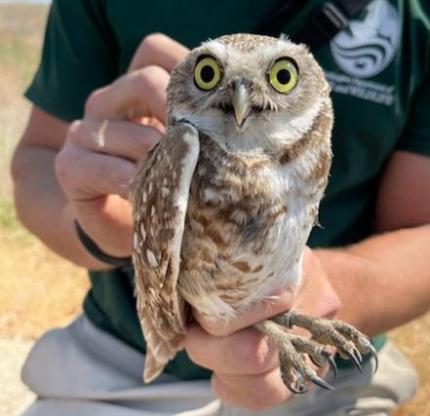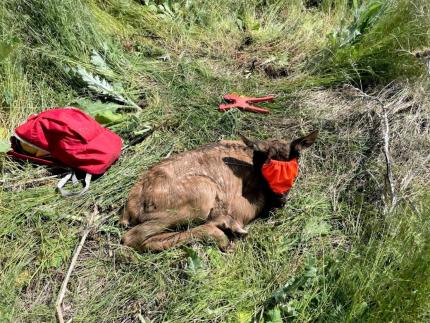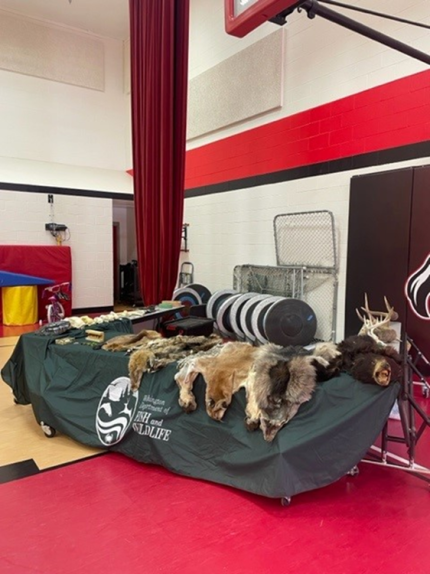Managing Wildlife Populations
Burrowing Owl Artificial Burrow Project: District 4 Wildlife Biologist Fidorra monitored and banded burrowing owls as part of an ongoing research project utilizing artificial burrows. Fidorra got help from Assistant District 8 Biologist Wampole and Region 2 technicians during this period to band and trap adults and nestlings in the artificial burrows. Fidorra also assisted US Fish and Wildlife Services with monitoring and banding at their Paterson Unit where owls are using the burrows for the first time in several years! Fidorra also toured the Energy Northwest Powerplant property where 8 clusters of artificial burrows were created. This is the first time WDFW has been to the site, and while the burrows were in good order, no owls were nesting this season.


Burrowing Owl Transmitter Project: District 4 Wildlife Biologist Fidorra worked with University of Idaho Researcher Conway to deploy and test new solar tracking devices GPS accuracy on burrowing owls in Pasco. Fidorra also deployed trail cameras onsite to monitor the adults to make sure the harness and transmitter package worked without impacting the owls.

Fisher Monitoring: District 8 Wildlife Biologist Wampole began retrieving fisher monitoring sites that were placed in fall 2022. Sites were left over winter and spring to monitor for fisher occupancy and is part of a large effort across the southern Cascades to evaluate the status of fisher following reintroductions.
Bear Monitoring: Bear monitoring sites were installed in portions of the Oak Creek Wildlife Area and the Okanogen-Wenatchee National Forest in District 8. Sites are designed to capture hair from curious bears in the area using barbed wire strung around a stand of trees with a scent lure in the center. DNA analysis will be conducted on hair samples and used to estimate bear density in the area. This monitoring effort is led by Statewide Bear and Cougar Specialists Beausoleil and Welflet.
Pelican and Tern Colony Monitoring: District 4 Wildlife Biologist Fidorra and US Fish and Wildlife Service McNary and WDFW staff members joined the Real Time Research contractors for a boat based colony survey of terns, gulls, and white pelicans on the Columbia River. Some of the first fledglings of the year were detected. Fidorra also worked on analysis of aerial colony images taken by WDFW in May, for the annual adult pelican count on Badger Island.

Tri-Cities Goose Banding: District 4 Wildlife Conflict Specialist Hand, Private Lands Biologist Hulett and Technician Manderbach participated in a goose round-up and banding project at Columbia Park in Kennewick.
Blue Mountain Elk Collaring: Sunnyside-Snake River Manager Kaelber assisted WDFW staff members and others with collaring elk calves in the Blue Mountains for a calf survival study.
State Wildlife Action Plan Process Review: District 4 Wildlife Biologist Fidorra provided comments and attended the State Wildlife Action Plan (SWAP) process review meeting in preparation for the 2025 SWAP update. The process outlined how species would be selected for inclusion in the SWAP as Species of Greatest Conservation Need.
Blue Mountains Elk Collaring: Colockum Wildlife Area Manager Lopushinsky and Assistant Manager Hagan also assisted WDFW staff members and others with collaring elk calves in the Blue Mountains for a calf survival study. Staff members worked in rugged terrain spotting cow elk with calves and then hiking to get close enough to capture and collar newborn calves.



Providing Conflict Prevention and Education
Reducing Vehicle Collisions: District 8 Habitat and Wildlife staff members, met with a Washington Department of Transportation biologist and engineers to begin discussion of our prospects for safe passage of wildlife to reduce wildlife vehicle collisions and improve connectivity.
Bear Cub Orphan: District 8 Wildlife staff members and police responded to a report of an orphaned bear cub on private land. The 3–4-month male cub was safely located, captured, and transported to a wildlife rehabilitation facility. The cub was determined to be in good condition and is slated for release in spring 2024.
Rattlesnake Hills Elk: District 4 Wildlife Conflict Specialist Hand continues to monitor elk activity and damage impacts while actively preforming late night/early morning hazing patrols. As natural forage dries-out and crop fields mature, increasing numbers of elk continue to raid wheat fields along the top of Rattlesnake Mountain, mostly during nocturnal hours.

Richland Coyote: District 4 Wildlife Conflict Specialist Hand responded to a complaint from a homeowner near Badger Mountain concerning a coyote that was hanging around residences. “Living with Wildlife” material was discussed as well as actions that can be taken to protect pets.
Providing Education and Outreach
Public Presentation Deer and Elk: Assistant District 8 Biologist Wampole presented to the Kittitas Field and Streams Club on the status and trends of the elk and deer in District 8 and answered questions regarding concerns around mule deer and elk in the area.
Mesa Elementary Ecology Day: Assistant Manager Jahns attended Mesa Elementary School’s Ecology Day. The entire K-6 student body rotated through different educational stations throughout the day learning about all things ecology! The students were very enthusiastic about Washington Department of Fish and Wildlife. It was a fun, action-packed day of learning!

Other
District 4 staff members in Pasco prepared for the furniture update of desks and cabinets expected in the coming week. Wildlife Biologist Fidorra worked to secure a contract with moving companies while everyone cleaned and prepped to remove old furniture once the new arrives.
Conserving Natural Landscapes
Diffuse Knapweed Control: Oak Creek Technician Boggs and Assistant Manager Charlet released biocontrol insects (bangasternus farsti) to help control dense diffuse knapweed patches in the Cowiche Unit of the Oak Creek Wildlife Area. Biocontrol insects were provided by the Washington State University Extension as part of the integrated weed control project.


Sunnyside/Snake River Weed Control: Manager Kaelber and Technician Manderbach removed large patches of Scotch thistle from the I-82 Ponds Unit. Sunnyside/Snake River Wildlife Area staff members continue to apply integrated pest management strategies to control invasive weeds throughout the wildlife area.
